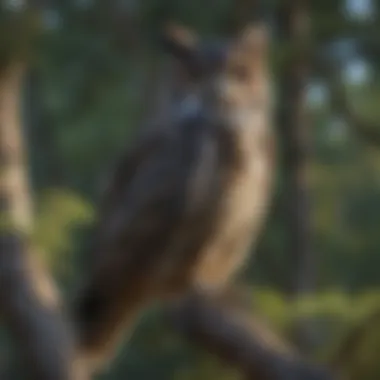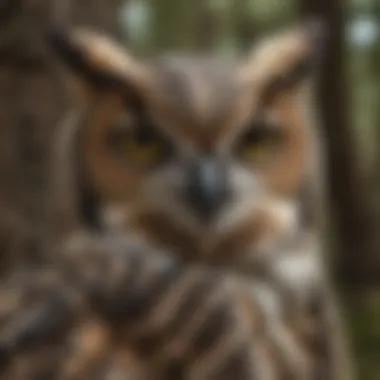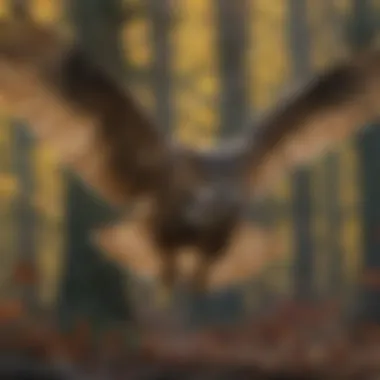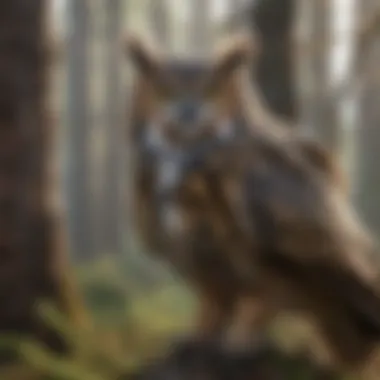Exploring the Dietary Habits of Great Horned Owls


Nature Topic Overview
The great horned owl is an iconic bird, known for its distinctive tufts and impressive hunting skills. This section introduces the dietary habits of these fascinating creatures, offering insight into what they eat and how they adapt their feeding strategies to survive.
Great horned owls are versatile predators, thriving in diverse habitats across North and South America. Their diet includes a wide range of prey. This adaptability reflects their ecological role, as they help control populations of rodents and other animals. Understanding their dietary habits is essential, as it reveals much about their hunting techniques, nutritional needs, and overall impact on the ecosystem.
Fun Facts and Trivia
- Great horned owls can weigh between 2 and 5.5 kilograms.
- They have powerful talons that can exert up to 28 kg of pressure.
- These owls can rotate their heads up to 270 degrees to survey their surroundings.
- They are not picky eaters. Their diet can include rabbits, birds, and even small deer.
- Great horned owls are known for their deep, resonant hoots, which can be heard from great distances.
Engage your imagination and learn more with visuals that show their feeding habits. Interactive elements, like quizzes, can make learning about owls fun and informative.
Wildlife Explorations
Great horned owls share their habitats with many other species. Some related birds include the barn owl and the snowy owl, both of which also hunt small mammals but in different ways. Understanding these relationships helps explain the dynamics of local ecosystems.
In the forests and fields where great horned owls live, many other creatures can be found. For instance, red-tailed hawks also prey on similar animals but may compete for food.
Fun facts about their habitats might include:
- Various plants provide shelter for prey.
- Different weather conditions can affect hunting success.
Similar animals, like the red-tailed hawk or the American kestrel, also offer interesting comparisons in hunting styles and dietary habits.
Environmental Awareness
Conservation plays a critical role in the survival of great horned owls. They depend on healthy ecosystems to find food and shelter. As such, it's vital to protect their habitats from pollution, deforestation, and urban expansion.
Children can get involved in conservation efforts. Here are some tips:
- Participate in local clean-up events to help protect wildlife areas.
- Learn about local birds and share knowledge with friends and family.
- Create bird feeders to attract and support local bird species in your backyard.
DIY Nature Activities
Engaging with nature is a wonderful way to understand great horned owls better. Here are some quick activities:
- Create Owl Art: Use paper and colors to make drawings or paintings of great horned owls.
- Feeding Habit Journal: Observe birds in your area and keep a log of what you see them eat.
- Outdoor Scavenger Hunt: List items related to owls and see how many you can find outdoors.
- Shadow Play: Use light to create shadows of owls and explore how they hunt at night.
These activities can deepen your connection with nature and the creatures that inhabit it.
By embracing scientific exploration and creativity, we can foster a greater appreciation of wildlife and its importance in our lives.
Preface to Great Horned Owls
Great Horned Owls (Bubo virginianus) are among the most recognizable owls in North America. Understanding their dietary habits is crucial for several reasons. First, their diet is a reflection of their role within the ecosystem. As apex predators, they help maintain the balance of wildlife populations, influencing both prey and predator dynamics. This section will provide insights into two essential aspects: their physical characteristics and habitat distribution, forming a foundation for comprehending their feeding behaviors.
Physical Characteristics
Great Horned Owls are notable for their distinctive appearance. They possess tufted "horns," which are often mistaken for ears. These tufts actually play a role in communication and camouflage. An adult Great Horned Owl can weigh between 4 to 5.5 kg and have a wingspan of about 1.2 meters. Their plumage varies in color but generally features a mottled pattern of browns and grays. This coloration aids in blending into their environments, which is essential when hunting.
Their large, yellow eyes provide excellent night vision, allowing them to spot prey in low-light conditions. The strong beak is well-adapted for capturing and consuming various types of prey. This anatomical structure enables them to exert significant force, making them effective hunters. The physical traits of Great Horned Owls not only enhance their ability to hunt but also reflect their adaptation to diverse habitats.
Habitat and Distribution
Great Horned Owls are found throughout North America, from the northernmost regions of Canada down to Central America. They inhabit a range of environments including forests, mountains, and urban areas. Their adaptability to various habitats allows them to thrive in both rural and urban settings.
These owls typically reside in cavities of large trees or on cliff ledges, providing shelter and vantage points for hunting. Their range often overlaps with numerous other bird species and small mammals, allowing them access to a rich variety of prey.
In more urban environments, Great Horned Owls have adapted by using buildings and parks as habitats. This ability to thrive in diverse surroundings makes them a significant subject of study for understanding wildlife adaptation and ecological health.
"The Great Horned Owl stands as a symbol of strength and adaptability in the avian world."


By examining the physical characteristics and habitat distribution of Great Horned Owls, one can better appreciate the complexity of their dietary habits and their vital role in the ecosystem.
Fundamentals of Owl Diet
General Feeding Behavior
Great horned owls exhibit a highly opportunistic feeding behavior. They will consume a wide variety of prey based on availability. This can include small to medium-sized mammals, birds, reptiles, and even insects. Generally, their hunting occurs at night, which aligns with their nocturnal nature. During the twilight hours, they utilize their sharp vision and acute hearing to locate prey. Their ability to hear faint sounds enables them to pinpoint the location of even the most secretive creatures in the dark.
When hunting, great horned owls often sit quietly on a perch, waiting patiently for prey to appear. Once they spot their target, they swoop down with incredible speed and precision. The bird's talons are strong, ensuring that once they grasp their prey, escape is unlikely. Great horned owls also use their silence to their advantage. Their feathers are specially adapted to minimize noise, allowing them to approach prey unnoticed. This specialized hunting behavior is pivotal for their survival in various environments, from forests to urban areas.
Importance of Diet in Ecosystems
"Great horned owls symbolize a critical link in the food chain; their presence indicates a healthy ecosystem."
Additionally, the remains of their prey contribute to nutrient recycling in their habitats. As owls consume and digest their food, the waste they produce enriches the soil and provides nutrients for plants. Thus, the great horned owl digestion process not only supports their dietary needs but also plays a role in ecosystem health and regeneration.
In summary, the fundamentals of owl diets are not just about what they eat. It's about understanding their strategies, adaptations, and the crucial role they play in enriching their ecosystems. For young readers, this offers an engaging glimpse into the interconnectedness of nature, illustrating the circle of life in a vivid way.
Types of Prey Consumed
Understanding the types of prey consumed by great horned owls is essential to grasping their role in the ecosystem. Their varied diet showcases their adaptability and hunting skills. These aspects highlight not only their efficiency as predators but also their impact on controlling prey populations. Learning about their prey allows us to appreciate their ecological significance and the intricacies of their feeding habits.
Mammals
Rodents
Rodents make up a large portion of the great horned owl's diet. These small mammals, including voles, mice, and rats, are abundant and relatively easy to catch. They are a beneficial choice for the owl due to their high availability in many habitats. Rodents provide essential nutrients, particularly protein and fat, which are crucial for the owl's energy needs. These animals are often nocturnal, making them available for owls to hunt during their active hours.
Rabbits
Rabbits also play a significant role in the diet of great horned owls. Their size and abundance make them a popular prey choice. Rabbits are known for their rapid movement, which can pose a challenge during hunting. However, they have a high caloric content, making them an advantageous meal. Eating rabbits helps maintain a balance in their population and ensures that the owl has sufficient energy for its demanding lifestyle.
Squirrels
Squirrels are another preferred prey for great horned owls. Their agility and climbing abilities allow them to escape from many predators. However, owls can outsmart them, especially in wooded areas. Squirrels are rich in fats, which provide a high-energy source for the owls. This makes them a valuable food source, especially during colder months when energy needs increase.
Birds
Smaller Birds
Great horned owls occasionally hunt smaller birds. These birds, such as sparrows and finches, may not be the primary food source but are easily accessible. Their presence in the owls' diet helps demonstrate the diversity of prey choices. Smaller birds tend to be less challenging for owls to capture, especially when hunting in less dense vegetation.
Songbirds
Songbirds are another category consumed by great horned owls. These birds are usually more colorful and vocal, making them interesting to observe in the wild. However, their small size makes them vulnerable to the great horned owl's hunting skills. Including songbirds in their diet allows owls to diversify their nutrient intake.
Waterfowl
Waterfowl such as ducks and geese can also be part of the diet, particularly where these species are abundant. Waterfowl offer a good source of protein; however, they can be harder to find and catch compared to other birds. The advantage is that when available, waterfowl can provide a substantial meal, supporting the owl's energy needs.
Reptiles and Amphibians
Snakes
Great horned owls will occasionally hunt snakes. These reptiles can be quite nutritious and are often less active, making them easier to catch. Snakes are a good food source, especially in regions where they are common. However, caution must be observed since some snake species can be dangerous, providing potential risks for the owl.
Lizards
While not a primary food source, lizards do appear in the diets of great horned owls. These reptiles are often smaller and can be less nutritious compared to other prey. Yet, they are abundant during warmer months, offering an alternative food option when other prey may be scarce.
Frogs


Frogs can also be consumed by great horned owls, particularly in wetland areas. They offer a good source of moisture and protein. Their presence in the owl’s diet shows the flexibility in feeding habits. However, frogs are not as commonly hunted as other prey items due to their elusive nature.
Insects
Beetles
Insects, especially beetles, are part of the great horned owl’s diet. These small creatures are plentiful and can be found in various habitats. While beetles do not provide as much energy as larger prey, they still contribute to the owl's diet. Their small size can make them easier to catch during suitable hunting conditions.
Caterpillars
Caterpillars may not be a main food choice for great horned owls, but they do play a role in their flexible diet. These larvae are available during specific seasons, adding some variety. They are relatively easy to capture and can support juvenile owls in their developmental stages. However, caterpillars are less energy-rich than other prey.
Grasshoppers
Grasshoppers are a common choice among insects. They offer a good source of protein and are often found in grasslands. Although not a primary food source for great horned owls, they provide necessary nutrition during certain times of the year. Flexibility in diet helps these owls thrive in diverse environments.
In summary, the variety of prey consumed by great horned owls illustrates their adaptability and critical role in the ecosystem. By preying on different species, they help maintain a balance within their habitats.
Hunting Techniques
Understanding the hunting techniques of great horned owls is crucial in appreciating their role as effective predators in various ecosystems. These techniques not only highlight the owls' remarkable adaptations but also their strategies for survival. The combination of their unique abilities makes them one of the top hunters in the avian world. Here, we will explore three significant components of their hunting techniques: nocturnal hunting, silent flight, and adaptations in their vision and hearing.
Nocturnal Hunting
Great horned owls are primarily nocturnal hunters. This means they are most active during the night. Their hunting strategies have evolved over time to suit this behavior. The nocturnal lifestyle allows them to take advantage of the darkness to approach prey undetected.
When hunting, great horned owls often perch high in trees or on structures. From these vantage points, they scan the ground for movement. Their keen senses help them detect even the slightest disturbances caused by potential prey. Rodents, rabbits, and birds fall victim to their stealthy approach when there is little light. This hunting method minimizes risks and maximizes their success rates.
Silent Flight
Another impressive aspect of their hunting techniques is their ability to fly silently. Great horned owls possess specialized feathers that reduce noise during flight. The leading edges of their primary feathers are serrated, breaking up the turbulence that typically creates sound. This feature gives them an advantage over other birds, allowing them to swoop down on unsuspecting prey without alerting them.
The ability to fly silently is not just an advantage but a necessity. It enables great horned owls to hunt effectively and avoid detection by both prey and competitors. This stealthiness is essential for their survival and hunting success.
Vision and Hearing Adaptations
Great horned owls are equipped with extraordinary vision and hearing, both crucial for successful hunting. They have large eyes that provide excellent night vision, making it easier for them to see in low-light conditions. Their eyes can detect slight movements and variations in light, helping them locate prey with precision.
In addition to their impressive vision, their hearing is equally remarkable. Great horned owls can pinpoint sounds with great accuracy, allowing them to detect prey even when it is hidden under foliage or snow. Their ears are asymmetrical, meaning one ear is positioned higher than the other. This unique structure allows them to determine the direction and distance of sounds, further enhancing their hunting capabilities.
"Great horned owls are masterful hunters, combining stealth, silent flight, and acute senses to secure their place in the food chain."
Nutritional Needs
Understanding the nutritional needs of great horned owls is crucial to appreciating their role as apex predators. Their diet not only supports their health but also impacts the ecosystem. Great horned owls require a variety of nutrients to thrive, which they obtain from their prey. These nutrients include proteins, fats, and essential vitamins. Each nutrient plays a fundamental role in maintaining their energy levels, supporting growth, and ensuring reproductive success.
Caloric Requirements
Caloric intake is essential for great horned owls, as it directly affects their survival. On average, these owls consume about 20% of their body weight in food each day. This number varies based on factors like age, activity level, and availability of prey. Young owls tend to require more calories as they are growing rapidly and need energy for their development. Adults, on the other hand, might adjust their intake based on seasonal changes in prey abundance.
By meeting their caloric needs, great horned owls can maintain optimal health and ensure they are agile hunters. Locating and capturing adequate prey provides them with the revengeful energy needed for nocturnal hunting activities. This adaptability is valuable in changing environments, where food supplies may fluctuate.
Role of Protein in Diet
Protein is one of the most critical components of the diet for great horned owls. It supports muscle development and repair, particularly important for a bird that engages in strenuous activities such as hunting and flying. The primary source of protein comes from the mammals, birds, reptiles, and insects that they consume.
High-protein prey options, like rabbits and rodents, help meet the nutritional demand of these owls. Additionally, more protein-rich food promotes healthy feather development and supports overall physical condition. Owls that consume a diet low in protein may exhibit poorer health, affecting their hunting skills and reproductive success.
Impact of Habitat on Diet
Understanding the impact of habitat on the diet of great horned owls is vital for several reasons. These owls are versatile predators, yet their feeding habits are influenced significantly by their environment. They have adapted their hunting strategies and prey selection based on where they live, whether in urban areas or rural landscapes. This section explores how different habitats shape the dietary patterns of these fascinating birds.


Urban vs. Rural Environments
Great horned owls inhabit a variety of environments, including densely populated urban areas and serene rural settings. Each habitat presents unique challenges and opportunities that directly affect their diet.
In urban areas, great horned owls often face a different composition of prey. Common sources of food include:
- Pigeons
- Rats
- House sparrows
- Cats
These prey items may be more readily available due to higher human activity that influences local ecosystems. For example, as people provide more food scraps and create habitats, populations of some prey species, like rodents, may increase.
On the other hand, in rural environments, owls have a broader range of natural prey. Here they may hunt larger mammals and birds, such as:
- Rabbits
- Squirrels
- Waterfowl
Rural habitats generally offer more diverse ecosystems, allowing great horned owls to maintain a more varied diet. This diversity is crucial for their nutritional needs and overall health. While urban environments may afford some advantages in terms of prey abundance, rural environments provide the richness that these owls often require.
"The adaptability of great horned owls showcases how they can thrive across different landscapes, but it also raises concerns regarding habitat conservation and its effect on prey availability."
Seasonal Variations in Prey Availability
Seasons bring significant changes to the diets of great horned owls. As weather patterns shift, so does the availability of their prey.
In spring and summer, the increase in young animals and insects makes food abundant. During these months, owls can find:
- Baby rabbits
- Nesting birds
- Newly emerged insects
These seasonal food sources provide essential nutrients, allowing owls to raise their chicks successfully. In contrast, autumn and winter present challenges as many prey species become less available. For example:
- Rodent populations may decline after harvest, reducing food sources in agricultural areas.
- Migratory birds leave, affecting hunting opportunities.
During this time, great horned owls may adapt by altering their hunting techniques or focusing on different prey types. This adaptability is crucial for their survival during seasonal changes.
Conservation and Dietary Health
The conservation of great horned owls and their dietary health are deeply interconnected. Understanding this relationship is crucial for maintaining stable ecosystems. Great horned owls serve as apex predators, meaning they help control the population of their prey, which includes small mammals, birds, and insects. A balanced diet is not just essential for the owls' survival; it also reflects the health of their habitats.
The overall health of an owl's diet can indicate environmental conditions. If their prey availability decreases due to human activities, this can lead to malnourishment of the owls and disrupt their breeding. Protecting their natural habitats allows the recovery of prey populations, which directly benefits the great horned owls and contributes to the ecological balance.
Human Impact on Prey Availability
Human activities significantly impact the availability of prey for great horned owls. Urban development, farming, and pollution reduce the habitats needed for various mammals and birds. For instance, as forests are cleared for agricultural purposes, the population of rodents and smaller birds also declines. This not only affects owls' food supply but can also result in competition with other species for fewer resources.
Additionally, pesticide use in agriculture can poison the very animals that owls rely on. Rodents and small birds that consume these chemicals become sick or die, leading to a decrease in numbers. This creates an alarming ripple effect throughout the food web, making it even harder for great horned owls to find enough food.
Protecting Great Horned Owl Habitats
Protecting the habitats of great horned owls must be a priority if we want to ensure their dietary health. Conservation efforts can include creating wildlife reserves and enforcing laws that limit habitat destruction. These measures help maintain the natural environments where owls hunt and breed.
Local communities can play a role in these efforts. Educating people about the importance of wildlife conservation can foster a sense of responsibility toward protecting owl habitats. Simple actions, such as reducing the use of harmful chemicals and preserving green spaces, can create a more hospitable environment for these owls.
"A healthy environment not only sustains great horned owls but promotes biodiversity, which benefits countless other species as well."
Through consistent and focused efforts, it is possible to secure the future of great horned owls. This protection will ensure a robust population of their prey, allowing the owls to thrive and continue their important role in the ecosystem.
Epilogue
Summary of Great Horned Owl Diet
The great horned owl's diet is remarkably diverse. They are not picky eaters and consume a wide variety of prey. Their primary food sources include:
- Mammals: They are well-known for hunting rodents like mice and rats, but they also target larger prey such as rabbits and squirrels.
- Birds: These owls will take smaller birds, including songbirds and waterfowl, demonstrating their adaptability and skill in hunting.
- Reptiles and amphibians: Great horned owls can eat snakes, lizards, and even frogs when the opportunity arises.
- Insects: They include various insects like beetles and grasshoppers in their diet, showcasing their versatility.
Each category of prey contributes to their nutrition and energy needs, making it essential for their survival. Their ability to shift diets based on availability highlights their adaptability in varying environments.
Importance of Continued Research
Furthermore, continuous study aids in conservation efforts. Specific regions may require management strategies to ensure that both the owls and their prey species flourish. Gathering data about their diets can also help in educating communities about coexistence with wildlife.







